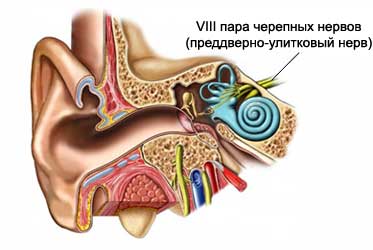A cochlear implant
Description of the cochlear implant
Kohlearnыy implant – surgically implanted electronic device. It helps provide hearing people, that have some type of hearing loss. It, as rule, damage or defect in the inner ear. Implants directly stimulate the auditory nerve, sending information to the brain.
A cochlear implant consists of three parts:
- Speech Processor – It looks like a long, narrow calculator. It is worn behind the ear or on a belt, amplifies sound, converts it into a digital signal and sends these signals to a transmitter;
- Transmitter – Transmitter Earphone, which is worn behind the ear. It receives electrical signals from the speech processor, and transmits it through the skin to the receiver.
- Receiver – part of the device, which is implanted in the ear. It is a magnetic disk about the size of a coin. It is located under the skin behind the ear. The wire extends from the receiver to the electrode, which is placed in the inner ear, which stimulates the auditory nerve.

When installing a cochlear implant?
Cochlear implants provide improved hearing for adults and children with profound loss of his. They are intended for humans, whose hearing does not improve after surgical correction or the use of hearing aids. Cochlear implants will not restore or correct hearing.
Possible complications of cochlear implant installation
Complications are rare, but no procedure does not guarantee the absence of risk. Before, how to install a cochlear implant, you need to know about possible complications, which may include:
- Infection;
- Nerve Damage, close;
- Problems with balance;
- Emotional distress due to the high expectations, and,, that can provide equipment;
- Poor quality of hearing after surgery.
Some factors, that may increase the risk of complications include:
- Smoking;
- Previous surgery;
- Have ear infections;
- Abnormal anatomy of the ear.
How is the installation of a cochlear implant?
Preparation for the procedure
- Otologic evaluation ear – the external and middle ear are examined to detect anomalies or infections;
- Audiometria (Assessment of hearing) – hearing test, which indicates, how well the patient can hear without a hearing aid;
- MRT or CT scan – These tests are conducted, to check the anatomy of the inner ear;
- The study of the history and examination is necessary to determine, Is general anesthesia safe;
- Psychological assessment – It may be recommended, to determine, how the patient will be satisfied after cochlear implantation.
Before the procedure:
- The patient may be asked to stop taking certain medicines a week before the procedure,:
- Aspirin or other anti-inflammatory drugs;
- Blood-thinning drugs, such as clopidogrel or warfarin;
- We need to organize a trip to the hospital and back after surgery, as well as help at home after the procedure;
- In the evening before surgery you can eat a light meal. You can not eat or drink anything after midnight on the day of the procedure.
Anesthesia
Used general anesthesia. At its application the patient will sleep during the procedure.
Description of the installation procedure of cochlear implant
The operation consists of two parts:
- Implantation of receiver – in the skin behind the ear incision. The bone behind the ear hole to be drilled, to get to the cochlea. Through the opening in the cochlea is summed electrode, transmits sound directly to the auditory nerve. The receiver is mounted on the bone behind the ear. The electrode is connected to a receiver. Razrez zakrыvaetsya paths.
- External connection – through 4-6 weeks, when the region of the operation will heal, They will be connected to the speech processor and a transmitter.
How long will the installation of a cochlear implant?
About 1,5-2 hours for adults, and up to five hours for children
Installation of a cochlear implant – it will hurt?
Anesthesia prevents pain during the procedure. The patient will feel some pain after surgery. The doctor will give pain medication, which reduce or suppress pain.
The average hospital stay
The length of stay depends on the specific circumstances. More detailed information can give the doctor.
Patient care after installing cochlear implant
Home Care
After the procedure, be sure to follow your doctor's instructions. We need to ask your doctor about, when it is safe to shower, bathe, or to expose the surgical site to water.
We need some more time to visit the hospital for the following purposes:
- Connect external devices – procedure is carried out through 4-6 weeks after surgery;
- Perform setting of the speech processor;
- We need some time to assess the state of hearing.
Besides, need to be trained, to improve the efficiency of the cochlear implant . This will help to improve some features:
- More precisely identify sounds;
- Read my lips;
- Extends language skills.
Contact your doctor after you install a cochlear implant
After discharge from the hospital need to see a doctor, If the following symptoms:
- Pain;
- Dizziness and vomiting;
- Twitching or paralysis of the facial nerve;
- Signs of infection, including fever and chills;
- Redness, edema, increased pain, bleeding, or any discharge from the incision;
- Cough, labored breathing, chest pain, severe nausea or vomiting.
